GOLDFINGER 5+ II & ABU MAILAH TOWER 5+ II
I assure Doug that I’ve belayed two ropes at once before, and it’s not entirely untrue. I tied into twins a few months ago, but never the doubles that Doug was now leading on — the first pitch of this trip and our first pitch climbing together. It’s a good thing the pitch is easy, because I fumble the belay hard. Double ropes are usually different colors so you can tell them apart when things inevitably get clustered, but the ones I borrowed for this trip are both the same drab brown color. And we tied in twisted. An auspicious start.
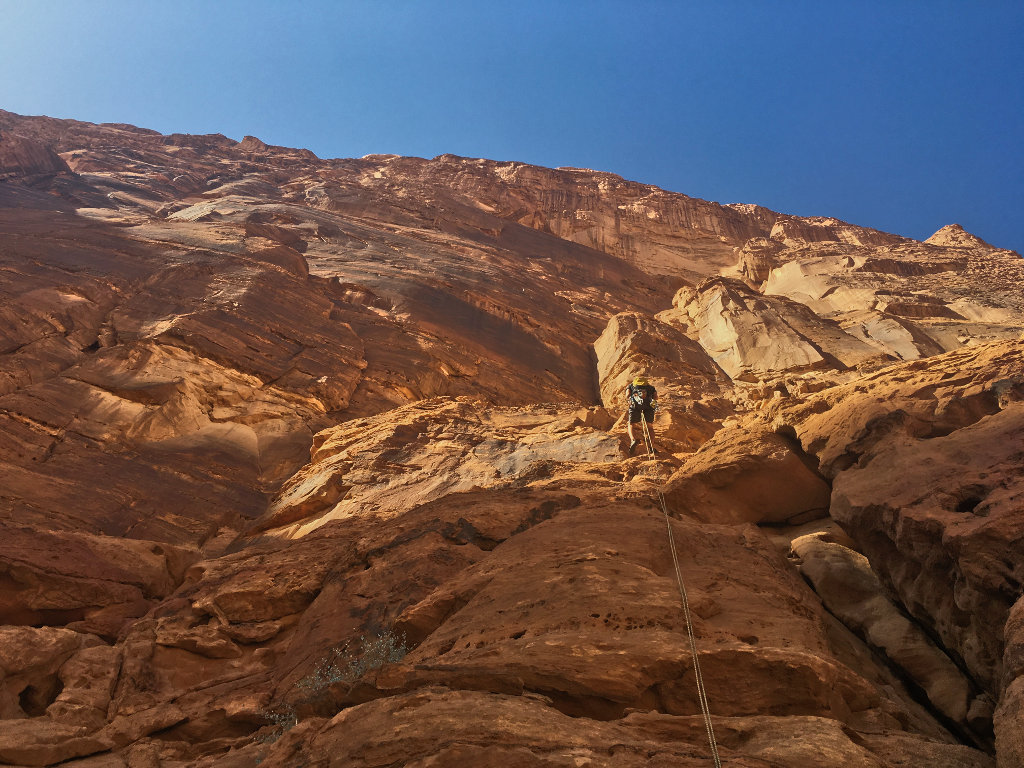
Goldfinger set an accurate trend for climbing in Wadi Rum: some junky adventure pitches, a few stellar pitches of splitter crack, a few spots of really runout face climbing, and an annoying and complex rappel descent. Luckily by the end of the junky adventure pitches we were both managing to keep a brake hand on both doubles ropes, and no one got dropped.
Doug got the Goldfinger money pitch, a 5+ (“That’s like, 5.9, right?) finger crack that was pretty classic. French grades are confusing, but 5+ felt fine. Were were surprised to find a couple of bolted rap stations on the way down from the Fingers, the formation that Goldfinger finishes on.
Next up, we hiked around into a super beautiful hanging valley between the big face of Jebel Rum and the north side of Abu Mailah tower for a short route to the tower’s summit. It was pretty much scrambling save for one 5+ pitch with a pretty wild novelty move pulling over a chimney roof.
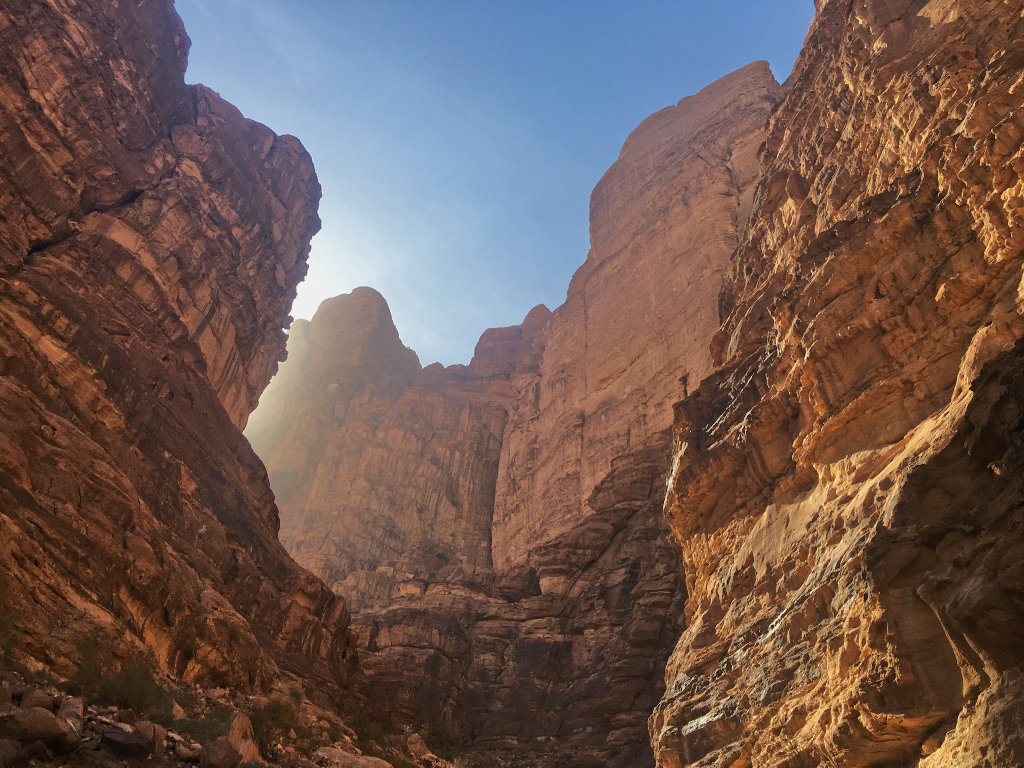
From the top of the tower we could see the vast and complex looking Jebel Um Ishrin massif stretching for miles north-south in the desert. Baggin’ towers in Jordan. Not bad for a first day.
BLACK MAGIC 5+ IV
The topos from the single, ancient guidebook published for Wadi Rum are vague at best and a child’s gesture drawing at worst. We’re going a little bit bigger today — twelve pitches or so, but still not harder than 5+ — on a named sub summit of Jebel Rum called the Black Tower. We gleaned from the topo that you climb up for a while, traverse for a while, and then climb up for a while again. So, nothing, basically. Which is okay.
Black Magic emphasizes the ‘runout face climbing’ portion of the Wadi Rum climbing formula. The runout sections are pretty easy, but scary as always. Good practice for finagling with weird gear. The rock changes a lot on this route, sometimes yarding on huge desert varnish plates, sometimes pawing up sandy slab, sometimes jamming clean corners.
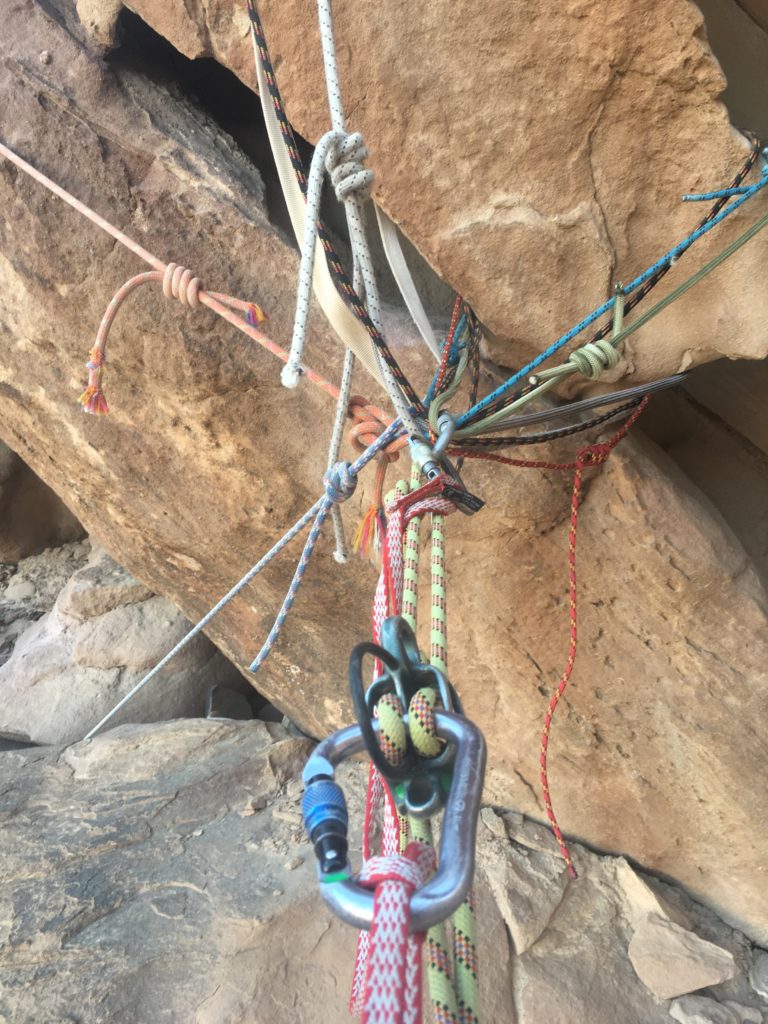
After a fun, dancing traverse around an arete the last few pitches of one long 5/5+ corner were the best on the route. It doesn’t go to the real top of the formation but rather under a steep, overhanging sandstone mushroom. It looked a little soft, but the giant toofahs eroded into the sandstone looked definitely climbable if they were bolted. Alas.
On the raps down we were surprised to toss our ropes onto a quiet duo from Italy, the first scent of other climbers in Rum on the trip. We chatted a bit before making it down in five or so raps — seeing the last tail of the ropes flip freely through the air and smack the ground was a big relief. Wadi Rum is infamous for stuck ropes and unplanned bivvies.
LIONHEART 6b IV
Lionheart breaks the Wadi Rum trend by delivering a smackdown of awesome splitter crack pitches. Also, all the belays are bolted. Whaaaat! It was our favorite route by far.
The first two pitches lead into five money pitches of mostly tight 6a and 6b corners. Pitch three is big moves between good finger locks in a right-facing corner for a while before it suddenly splits open to #5 BD, though you can get some face holds around the corner. The next pitch is a IC-style laser cut #4 splitter for 30 or so feet before choking into #2s and pulling onto a big ledge.
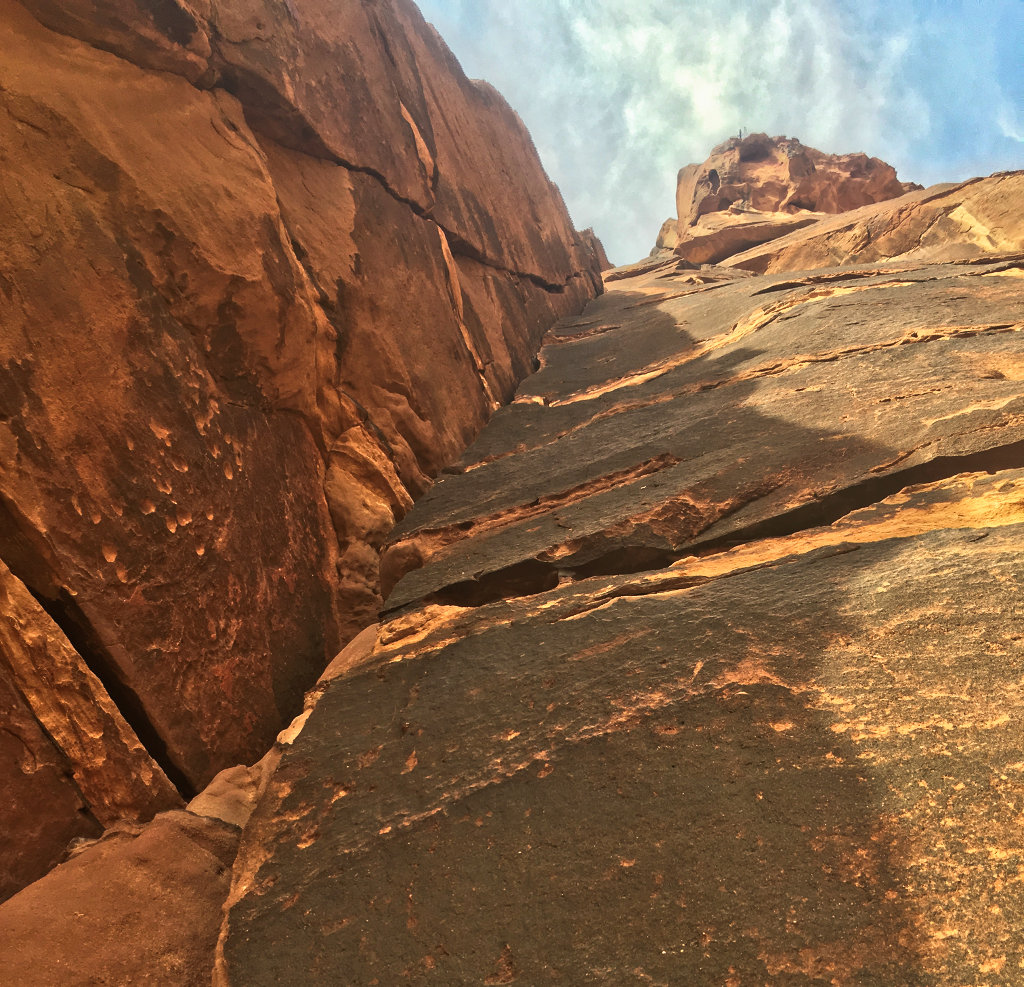
On pitch five you pull a few slabby face moves to flip-flop into another sweet corner, this one left facing, that you chase up into a brief squeeze chimney that leads to another comfy ledge. Next up, a cool stem-chimney chokes slowly up into a squeeze chimney into a small roof, after which you pull into another tight left-facing corner. This was probably my favorite pitch — it’s pretty wild to be smearing and finger locking in a corner one second and then huffing in a squeeze chimney the next.
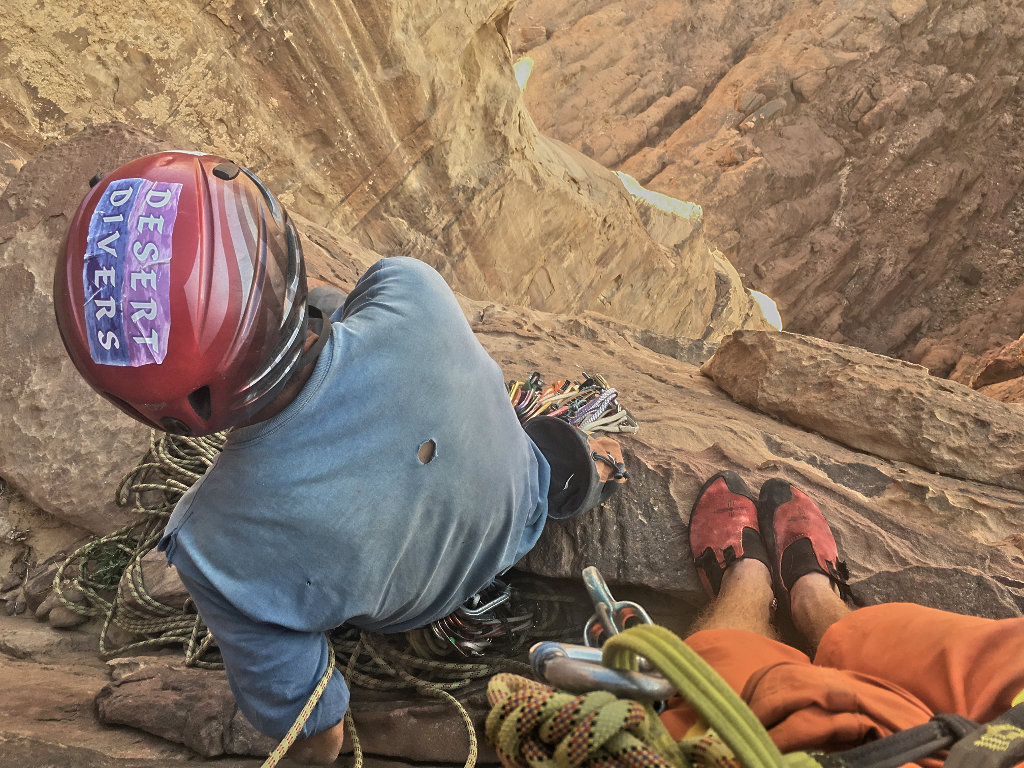
The last pitch had what was probably the stickiest rock I’ve ever climbed and required a hefty dose of faith in your footwork. Doug accidentally climbed around the “overhanging jam crack finale” described by the guidebook, but it was still a pretty sweet pitch. Again, no stuck ropes on the way down — woo.
THE STAR OF ABU JUDAIDA 6b IV
Another Barrah Canyon classic, and for good reason. I wasn’t psyched about the bottom third of the climb, but probably only because I won that lead: more runout face climbing to a really weird A0 section of fixed pins, a nasty traverse into an unprotectable chimney-crack-thing (cue heinous rope drag) and a weird belay. The next pitch was pretty rad though, and I was jealous of Doug’s lead. I think it’s a good sign in a climbing partnership when you argue about who gets to lead the harder pitches, but I digress.
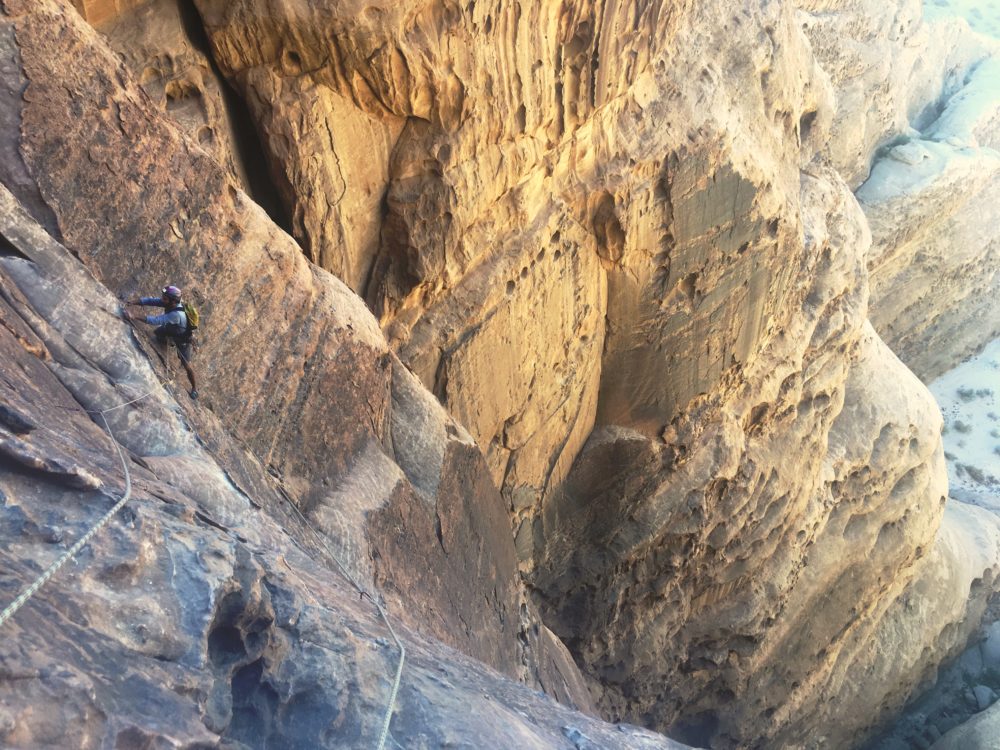
It was 50 meters of varied 6b corner with lots of cool variation; sometimes you had to jam it with smears and fingerlocks and other times there were huge desert varnish plates you could dance to on either side of the corner. The next pitch was another “uhg” pitch of runout 6a slab, though the FA had the rare decency of drilling and fixing one pin on the pitch.
The last few pitches were the money pitches and Doug and I divided them equitably. A strange and interesting slab-chimney (in which Doug spent ten minutes freeing a slightly-too-good hand jam) led to a burly roof pull to a wide section, where I watched the rope below me pop my tipped-out #4 out of place — good fun.
We broke our thus-far-clean track record of clean rope pulls, finally, and got one rope hopelessly snared above what was probably the worst pitch on the route. As is always the case when you realize the rap line is stuck, we bumbled around on the ledge for a while pitching feeble alternatives before Doug sucked it up and re-lead the pitch on our one free rope, cranking through and successfully freeing the crack-eaten rope. Cleaning the weird, traversing pitch was another ordeal, but we managed to land ourselves on the ground a couple of hours later with rope and rack intact.
MERLIN’S WAND 6a+ II & STORM 6a II
To our amusement, the ubiquitous “Supercrack of (crag name)” had found its way to Wadi Rum all the way from Utah. The Supercrack of Rum does seem fitting though, at least from afar: a perfectly vertical line splits the featured and bulgy sandstone face. The climbing isn’t quite the same as the American namesake, and though it was pretty cool we found it a bit overhyped.
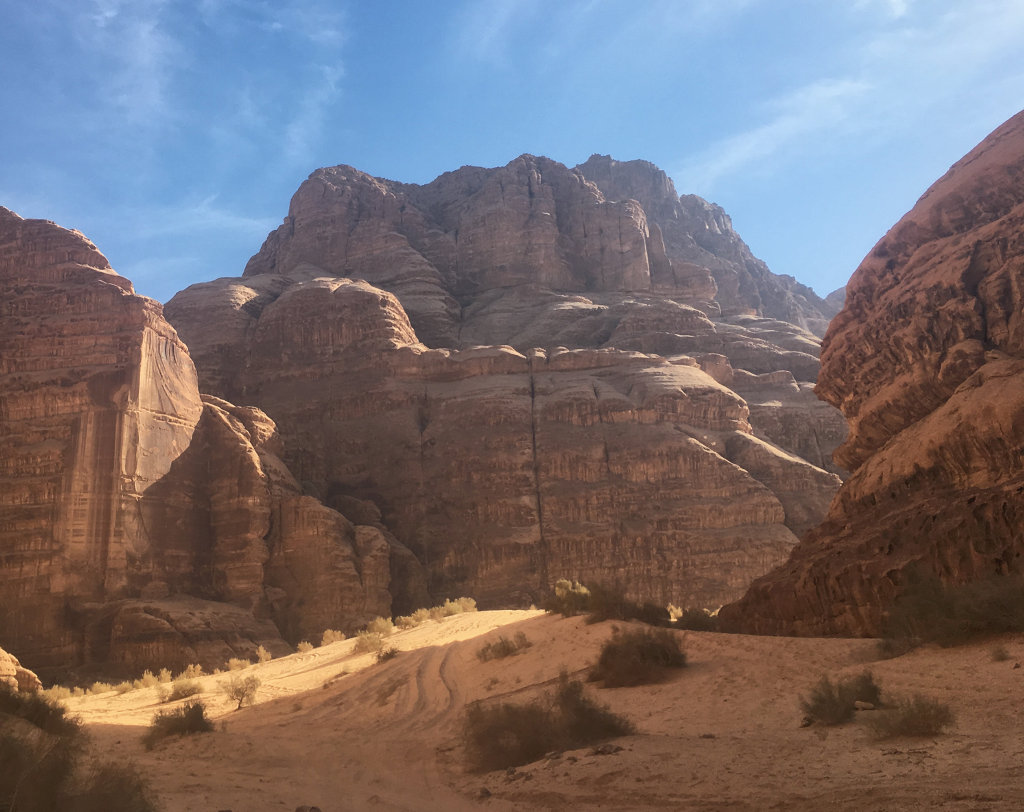
Most of your gear goes in the crack, but because it’s so recessed and pocked the climb is mostly plate pulling, with the hard bits being fun mini-roof pulls. We were surprised to meet a party of middle-aged Norwegian dudes queuing up at the base of the route when we got there but they were nice enough to let us go first as they were climbing three-up.
We did another route nearby called Storm. We think that’s what it was called, anyway, the topos being vague and all. It had a couple of forgettable approach pitches and a weird traverse into a really cool overhanging 6a stem chimney. The word ‘ledge’ scrawled onto the topo at the top of the route ended up being a long 50 degree chute that we begrudgingly roped back up for, having scrambled the pitch that leads to it. The rest of the epic canyoneering descent was much more memorable than the climb, with free-hanging rappels into pools of standing water and slot-style short raps. It was a lot of rapping and walking for one good pitch of climbing, but a nice adventure nonetheless.